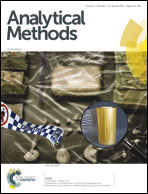Enhanced hydroxyapatite nanorods formation on graphene oxide nanocomposite as a potential candidate for protein adsorption, pH controlled release and an effective drug delivery platform for cancer therapy
Abstract
Herein, we report an eco-friendly hydrothermal synthesis of one dimensional (1D) hydroxyapatite (HAp) nanorods which were grown on two dimensional (2D) graphene oxide (GO) sheets (1D-on-2D) using creatine phosphate as a biomolecular source for phosphorus. Comprehensive analyses were performed to study the structural, morphological and bio-physical properties of the as-prepared nanocomposites using several analytical techniques. Enthrallingly, the as-prepared nanocomposite was explored to study the adsorption–desorption property of bovine serum albumin (BSA) on the HAp/GO nanocomposite. Notably, the observed data of adsorption–desorption process confirm the faster adsorption of BSA on HAp/GO nanocomposite. A maximum protein adsorption (Qo) of 350 mg g−1 in a neutral pH was attained for this nanocomposite and maximum release was obtained at a lower pH of 4. In addition, andrographolide, a model anticancer drug, was effectively loaded onto the HAp/GO nanocomposite through electrostatic and hydrophobic interactions. Experimental results showed that the HAp/GO nanocomposite not only exhibited good biocompatibility but also acted as good carrier for anticancer drugs, thereby greatly reducing the side effects of free anticancer drugs administered at high doses. Also, we include the results of the MTT assay of andrographolide loaded nanocomposite in a normal cell line (HaCaT) for selective anti-cancer activity. Therefore, the as-synthesized HAp/GO nanocomposite may act as a promising drug delivery platform due to its good biocompatibility, pH sensitivity, high drug loading efficiency, selectivity, and excellent biodegradability.



 Please wait while we load your content...
Please wait while we load your content...